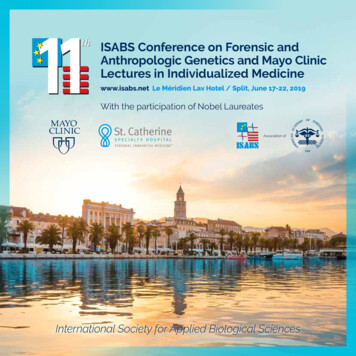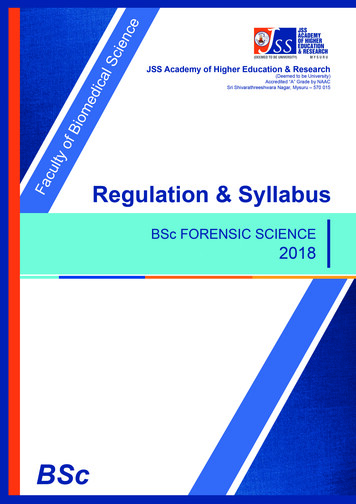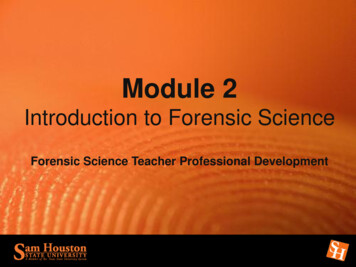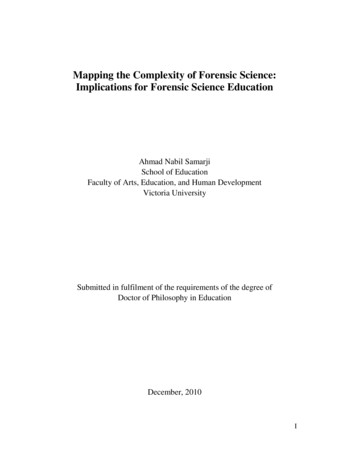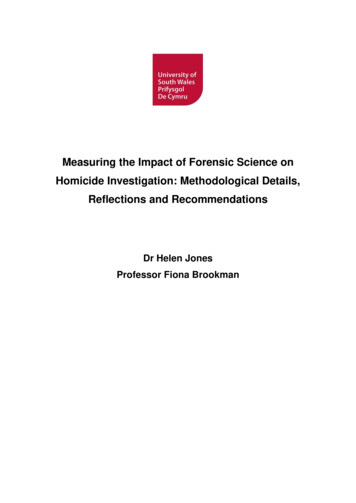
Transcription
Measuring the Impact of Forensic Science onHomicide Investigation: Methodological Details,Reflections and RecommendationsDr Helen JonesProfessor Fiona Brookman
ContentsExecutive Summary . 3Background . 3Data and Methods. 3Main Findings. 4Effectiveness of Forensic Science and Non-forensic Approaches . 4Timeliness of Forensic Science and Non-forensic Approaches . 5Effectiveness of Forensic Interventions . 5Conclusions and Recommendations . 6Methodological Recommendations . 6Recommendations for Policy and Practice for Homicide Investigation . 7Introduction and Background . 8The Impact of Forensic Science on Homicide Investigation . 9The Data: Homicide Investigation and Forensic Science (HIFS) Project . 13Proof of Principle Study – Phase 1 (July – September 2020) . 14Proof of Principle Study – Phase 2 (October 2020 – February 2021) . 18Findings . 21Effectiveness of Forensic Science and Non-forensic Approaches . 21Timeliness of Forensic Science and Non-forensic Approaches . 31Effectiveness of Forensic Interventions . 33Discussion . 42Effectiveness of Forensic Science and Non-forensic Approaches . 42Timeliness of Forensic Science and Non-forensic Approaches . 44Effectiveness of Forensic Interventions . 44Conclusions and Recommendations . 46Methodological Recommendations . 48Recommendations for Policy and Practice for Homicide Investigation . 49References . 50Appendix A: Impact points of forensic science on the criminal justice process. 53Appendix B: Column headings and a sample of data from the data capturespreadsheet . 542
Executive SummaryBackgroundForensic science plays an increasingly important role in the criminal justice system(CJS) by determining whether and how a crime has been committed, identifying andimplicating or eliminating suspects, validating accounts and establishing sequences ofevents (Kruse, 2016; Home Office et al., 2018). Although several studies haveexplored the impact of forensic science on homicide investigation they focus typicallyon a limited range of forensic evidence, in particular DNA, and on discretemoments/outcomes within homicide investigation, i.e. the arrest, charge andconviction of suspects. Little is known about how and when forensic science and digitaltechnologies (herein referred to as ‘forensic science’) contribute to broaderinvestigative outcomes.In January 2020, the Home Office initiated the Impact of Forensic Science Project todevelop an approach to measure, quantitatively, the impact of forensic science on theCJS. The overall objective of developing such an approach is to enhanceunderstanding of the role and impact of a wide range of forensic science at differentpoints of the CJS and in relation to different crime types. In order to achieve theseaims and develop a measuring tool, the Home Office collaborated with a number ofacademics, police services and other CJS stakeholders. This group includedProfessor Fiona Brookman and Dr Helen Jones from the University of South Wales(USW), who hold a unique and detailed qualitative dataset relating to British homicideinvestigations. The priority was to develop an approach to measuring ‘impact’ byevaluating the use of a forensic discipline on a series of ‘impact points’ (see AppendixA). Subsequently, the Home Office commissioned a series of proof of principle studiesthat applied the approach to different forensic disciplines and crime types, includingour homicide dataset.Data and MethodsThe homicide dataset that we drew upon in undertaking the proof of principle studywas gathered as part of the Homicide Investigation and Forensic Science (HIFS)Project. This was the first British ethnographic study of the role of forensic sciencesand technologies in the investigation of homicide. Data were gathered in relation to 44homicide investigations across four British police services. Thirty-three of theinvestigations were completed (or virtually completed) at the time of data gathering,the remaining eleven were ‘live’ homicide investigations that we observed as theyunfolded. The data included 144 interviews with practitioners, extensive fieldnotesmade during 700 hours of observations, and the analysis of hundreds of case papers.The obvious strength of our dataset is that it contains significant detail of eachinvestigation and the broad range of forensic science and non-forensic approachesthat were adopted in each case. A potential weakness of our dataset is that it containsthe details of only 44 homicide investigations and so we are unable to generalise our3
findings to all investigations across Britain. Nevertheless, given the depth of our dataand the diverse homicides and investigations that we studied, our findings provideimportant insights into how forensic science contributes to homicide investigation.Finally, our dataset generally captured successful instances where forensic disciplinesor digital technologies had been used to support investigations and we did notsystematically record instances where investigators had sought out forensic sciencebut the results had not contributed effectively to the enquiry.The proof of principle study was conducted in two phases allowing us to firstly refineand validate the practical application of the data capture spreadsheet and prove theprinciple of the methodological approach. To begin with, drawing on the homicidedataset, we populated an Excel data capture spreadsheet developed by the HomeOffice (see Appendix B for the column headings and a sample of data). Across the twophases, we examined 10 impact points. For each row of data inputted, we capturedup to seven forensic disciplines (e.g. DNA, toxicology, CCTV) and eight non-forensicapproaches (e.g. witness accounts, admission from an offender, call data or cell sitedata obtained from a communications service provider). Each row of data captured aninstance where we posed the question: has a forensic discipline or non-forensicapproach contributed to the impact point? For each separate forensic disciplinecaptured, we recorded whether it had contributed to the question posed for the impactpoint. Subsequently, the spreadsheet auto-populated whether or not forensic sciencehad contributed overall to the question posed for the impact point and whether anyforensic science had contributed exclusively to the question posed for the impact point(or whether in combination with non-forensic approaches).Main FindingsOur findings are organised around two broad metrics that were considered throughoutthe study: (1) effectiveness (how often forensic science contributes at a relevantimpact point) and (2) timeliness (how quickly forensic science contributes to the impactpoint) for the impact points populated.Effectiveness of Forensic Science and Non-forensic Approaches When forensic science and non-forensic approaches were used within the 44homicide investigations, they almost always contributed overall to an impact point(in 96% of instances when forensic science was used and in 98% of instanceswhen a non-forensic approach was used) Both forensic science and non-forensic approaches rarely contributed exclusivelyto an impact point (in 38% of instances when forensic science was used and in35% of instances when a non-forensic approach was used). Instead, in the majorityof instances, a combination of both forensic science and non-forensic approachescontributed to an impact point (within the main body of our report we consider howthese combinations/interactions took place)4
Timeliness of Forensic Science and Non-forensic Approaches For the 43 homicide investigations for which we had timeliness data, non-forensicapproaches contributed more quickly to an impact point than forensic science. Ittook, on average, 3 days for an answer to be obtained through a non-forensicapproach compared with 5.5 days for an answer to be obtained from forensicscience In comparison with the other impact points, it took longer to get an answer fromforensic science in order to establish cause of death and in order to eliminate asuspect (pre-charge and post-charge). In contrast, it took very little time for thepolice to answer the impact points establish crime committed and identify victimusing either forensic science or non-forensic approaches. Within the main body ofthe report we consider the reason for some of these delaysEffectiveness of Forensic Interventions By grouping several lesser-used forensic disciplines together we looked at thespecific contribution and effectiveness of each forensic discipline to each impactpoint. For the 44 homicide investigations studied, forensic pathology andanthropology was the most frequently used forensic intervention whereas digitalforensics was the least frequently used. However, in the context of this study,digital forensics only includes examinations by an expert1 When a forensic intervention was used, it contributed positively towards an impactpoint in 95% of instances. In particular, when toxicology was used, it contributedpositively in all instances. Very high success rates were also found for CCTV (97%)and forensic pathology and anthropology (96%). Chemistry and body fluidexamination were least likely to contribute positively to an impact point, withsuccess rates of 80% and 81% respectively CCTV had the greatest breadth of impact, contributing towards all 10 impact points,with toxicology having the least breadth of impact, contributing to just four impactpoints Forensic interventions varied in terms of the extent to which they contributed toeach impact point. Of note, compared to all other forensic interventions:o CCTV contributed most frequently to six impact points - ‘identify person ofinterest’, ‘eliminate suspect' (pre-charge), ‘eliminate suspect’ (post-charge),‘admission of guilt’ (pre-charge), ‘charge’ and ‘link designated scenes’;o Forensic pathology and anthropology contributed most frequently to twoimpact points - ‘establish crime committed’ and ‘establish cause of death’;o DNA / blood grouping contributed most frequently to the impact point ‘linkcrimes’1The Home Office decided that call data and cell site data (which are both provided by acommunications service provider and interrogated by intelligence analysts) would be classified as nonforensic approaches, whereas mobile phone downloads and cell site analysis would be designated asforensic disciplines because they require an expert to abstract and analyse the data. The Home Officealso decided that CCTV should be classed as a forensic discipline because it involves data recovery.5
Within the main body of the report we consider a number of reasons why particularforensic interventions may stand out from others in terms of frequency ofcontributionConclusions and RecommendationsThe proof of principle study demonstrated that the current methodology provides avaluable way of approaching and evaluating the impact of forensic science (and nonforensic approaches) across diverse impact points. Rather than focusing solely onstandard criminal justice outcome measures (such as charge or conviction rates), theapproach considers impact and value more broadly, recognising that forensic sciencecan contribute to investigative activity and overall success in diverse ways. It isenvisaged that other universities, police services or organisations will be able to applythe methodological approach outlined in detail in this report to other crime types orspecific forensic disciplines, or across a broader range of impact points. Furthermore,opportunities exist to analyse further the data gathered and to broaden ourunderstanding of how forensic science contributes to homicide investigation.Nevertheless, the proof of principle study highlighted some limitations with themethodology. In particular, the challenges of transforming often complex and detaileddata into rigid binary ‘yes/no’ options, which is often difficult to accomplish. In addition,the current approach does not allow the degree of impact to be recorded easily nordoes it capture the timeliness of each individual forensic discipline or non-forensiccontribution. We offer a number of recommendations that we hope will (1) assist theHome Office and others in developing and refining an efficient and effective processthrough which to capture and measure quantitatively the impact of forensic science onthe CJS on an ongoing basis, and (2) to enhance policy and practice for homicideinvestigation.Methodological Recommendations To enable a more detailed analysis of each individual contribution, each forensicdiscipline and non-forensic approach within the data capture spreadsheet couldinclude a drop-down box detailing whether it contributed and then further boxes tocalculate the timeliness. This would also reduce the need for additional commentson the spreadsheet, which were inevitably overlooked during analysis When applying the methodological approach to other crime types or specificforensic disciplines, the case-specific characteristics and demographics within thedata capture spreadsheet should be amended accordingly. This will allow a moredetailed understanding to be developed of how particular factors influence thetimeliness or effectiveness of the results obtained To further our understanding of impact, consideration could be given todistinguishing between the absence and presence of evidence. For example,distinguishing between a suspect being eliminated because there was no CCTVfootage to support them being in a particular location at the time of the offence6
(absence of evidence) and an offender being charged because they were caughton CCTV committing the offence (presence of evidence). This could be achievedby adding further drop-down boxes to the data capture spreadsheetTo advance our understanding of forensic disciplines and non-forensicapproaches, consideration could be given to recording the degree of impact foreach discipline/approach. This could be achieved by adding a numerical scale toeach discipline and approach or by adopting a colour-coding scheme (e.g. red,amber, green)To promote consistency across multiple studies, two tabs could be added at thebeginning of the workbook that (1) provide instructions about how to complete thedata capture spreadsheet and (2) define clearly all of the different forensicdisciplinesFor ease and in order to be able to duplicate information across multiple rows, endusers require permission to edit the spreadsheet. They will then be able to hiderows/columns and add filters to columnsFor ease and accuracy of recording timeliness data, a formula could be added tothe spreadsheet that calculates the number of days taken - i.e. the end-user insertsthe date that the offence was reported and the date that a particular result wasreceived, the spreadsheet then calculates the number of days taken to receive theresultRecommendations for Policy and Practice for Homicide Investigation In order to maximise the benefits of this methodological approach for all homicideinvestigations in the UK, it would be beneficial to capture relevant information withinone (or two) key documents (e.g. the senior investigating officer’s policy file,forensic case management system and/or formal debrief report) or by adapting anexisting information capture system (e.g. HOLMES). Users of thesedocuments/systems would need to be informed fully about the breadth and depthof information required, enabling sufficient data capture to assess a broad rangeof impact points. Currently, some significant decisions, such as eliminatingsuspects, are not recorded fully or transparently by police. These adjustmentswould also help to promote a more transparent disclosure process, ensuring thatboth the prosecution and defence are informed fully about the decisions made,actions taken and results received in each homicide investigation In order to maximise the contribution of different forensic disciplines and nonforensic approaches, consideration could be given to more effectively co-ordinatingdifferent investigative strategies, such as the forensic science strategy, CCTVstrategy, digital media strategy and house-to-house strategy. This will help toensure that findings from one investigative avenue effectively inform those ofanother, for example, by helping to target or focus other strategies Effective dialogue and collaborative working could be promoted to help to ensurethat findings from both forensic science and non-forensic approaches are used to7
identify further investigative or forensic opportunities, and to help inform otherexaminationsOpportunities exist to consider in more detail the timeliness data and whether thereare any benefits for the police or CJS in developing more streamlined and efficientprocessesConsideration could be given to exploring in more detail the degree of impact ofdifferent forensic disciplines in order to enhance our understanding of the valueand effectiveness of lesser-used forensic disciplines and their contribution tohomicide investigationsIntroduction and BackgroundForensic science plays an increasingly important role in the criminal justice system(CJS) by determining whether and how a crime has been committed, identifying andimplicating or eliminating suspects, validating accounts and establishing sequences ofevents (Kruse, 2016; Home Office et al., 2018). From crime scene to court, forensicscience has the potential to contribute intelligence, investigative leads or evidence(Bitzer et al., 2019: 13). Most recently, forensic evidence has incorporated tracesobtained from digital devices and almost every crime now contains some kind of digitalevidence (Vincze, 2016). Furthermore, demand for digital forensics has grown in thelast two decades, whilst demand for DNA and fingerprints has declined (Home Office,2016). Nevertheless, most of the published research has focused on the value offorensic science, in particular DNA, in decision-making at court, overlooking thediverse contribution that it can make at other stages of the CJS (Ribaux et al., 2017;Bitzer et al., 2019). Little is known about how and when forensic science and digitaltechnologies (herein referred to as ‘forensic science’) contribute to broaderinvestigative outcomes. As such, the Home Office, Association of Police and CrimeCommissioners, and the National Police Chiefs’ Council have argued for a system ofmeasuring the contribution of forensic science to the CJS (Home Office, 2016; HomeOffice et al., 2018).In January 2020, the Home Office initiated the Impact of Forensic Science Project todevelop an approach to measure, quantitatively, the impact of forensic science on theCJS. The overall objective of developing such an approach is to enhanceunderstanding of the role and impact of a wide range of forensic science at differentpoints of the CJS and in relation to different crime types. It is hoped that such anapproach will enable, for the first time, the evidence-based development of operationalpolice policy (at both a local and national level), help to inform budget, investment andresourcing decisions, and, in turn, create a way of measuring how decisions relatingto the financing and resourcing of forensic science, impact the CJS.In order to achieve these aims and develop a measuring tool, the Home Officecollaborated with a number of academics, police services and other CJS stakeholders.This group included Professor Fiona Brookman and Dr Helen Jones from the8
University of South Wales (USW), who hold a unique and detailed qualitative datasetrelating to British homicide investigations. The priority was to develop an approach tomeasuring ‘impact’ by evaluating the use of a forensic discipline on a series of ‘impactpoints’ (see Appendix A), using three metrics: (1) effectiveness (how often forensicscience contributes at a relevant impact point), (2) timeliness (how quickly forensicscience contributes to the impact point) and (3) cost benefit (how much does it costfor forensic science to contribute at the impact point). Drawing on our knowledge andexperience of homicide investigations, we acted as a ‘critical friend’, helping to refineand focus the impact points. Subsequently, the Home Office commissioned a seriesof proof of principle studies that applied the approach to different forensic disciplinesand crime types, including our homicide dataset.This report sets out details of, and reflections upon, the methodological approachadopted within the proof of principle study (completed in two phases). We begin bydescribing the homicide dataset that we drew upon in undertaking the proof of principlestudy, before moving on to outline both phases of the study and the collaborative,iterative processes that emerged. We then draw upon our analyses of our homicidedataset, reflecting upon the metrics of effectiveness and timeliness for the impactpoints populated.2 We end with some methodological reflections and implications forpolicy and practice for homicide investigation, including recommendations for futurework in this area. In order to place our findings in context, we begin with a brief reviewof the existing state of knowledge on the role and impact of forensic science onhomicide investigation.The Impact of Forensic Science on Homicide InvestigationMany studies – largely undertaken in the USA but also elsewhere – that have exploredthe impact of forensic science on homicide investigation focus typically on a limitedrange of forensic evidence in order to assess its contribution to the processing andoutcomes of homicide cases (e.g. Briody, 2004; Peterson et al., 2013; McEwan andRegoeczi, 2015). Findings reveal a mixed picture of whether forensic sciencecontributes positively towards homicide investigation. For example, Schroeder andWhite (2009) found that DNA evidence was used rarely by New York PoliceDepartment police officers investigating homicides in Manhattan (between 1996 and2003) and its use was not related to case clearances. Instead, it was most often usedwhen all other evidential and investigative options had failed, as a ‘tool of last resort’(p.337). Baskin and Sommers (2010) analysed records of 400 homicides (committedacross five American jurisdictions in 2003) from a larger National Institute of Justice(NIJ) study. They considered the influence of a wider range of forensic evidence,including DNA, fingerprints, pattern and trace evidence, and ballistic and firearmsanalyses. They found that forensic evidence did not have any significant influence on2We were unable to evaluate cost benefit because our homicide dataset did not include expenditure.9
case processing, i.e. arrest, referral for charge, charge and conviction (see alsoBrodeur’s 2010 research conducted in Quebec, Canada).More recently, Steele (2020) re-analysed over 4,000 cases from the NIJ study, 400 ofwhich were homicide cases. Focusing on the 400 cases, Steele found that forensicevidence was collected in all but 2.25% of cases and in 89% of cases, at least twotypes of evidence were collected. Steele considered whether the collection andanalysis of forensic evidence affected the probability of arrest, grouping the evidenceinto ‘identification’ (used to identify suspects, e.g. DNA or fingerprints), ‘classification’(used to reconstruct crime scenes, e.g. fired bullets or glass fragments) and‘progenitor’ (objects that can function as sources of multiple types of evidence, e.g.clothing which can yield hairs or fibres). 97% of homicide cases had classificationevidence, 86% had progenitor evidence and 60% had identifier evidence. Steele foundthat the collection of forensic evidence had no consistent effect on the likelihood ofarrest. However, the analysis of identification and progenitor evidence increased thelikelihood of arrest.Other studies that have considered specific forensic disciplines have also reportedlittle impact on homicide investigations. For example, King et al. (2017) intervieweddetectives who received a ballistics imaging hit report (that links two crimes involvingthe same firearm together) in 65 gun-related violent crime investigations (54 of whichwere homicides) in nine US police agencies. They explored whether case outcomeswere related to the presence of a hit report and found that detectives rarely benefitedfrom ballistics analysis because of the delays in producing these reports.Consequently, the reports rarely contributed to the identification, arrest, charging orsentencing of suspects. In another study, Ferrandino (2021) explored the decline inhomicide arrest rates in Chicago from 1965 to 2015. Although not a direct focus of hisstudy, Ferrandino noticed that this period of decline coincided with significanttechnological expansion in surveillance cameras and linked ShotSpotter sensors (thatdetect shootings) across the city. Ferrandino theorised that these technological toolsshould have improved the arrest rate because they reduce reliance on witnesses orother evidence and suggested that future research was necessary to consider the roleof technology in clearing homicides in Chicago.In contrast, other studies have reported more positive contributions. Braga et al. (2019)analysed police incident data for 465 homicides committed in Boston between 2007and 2014, and supplemented this with a review of investigative case files and in-depthinterviews with homicide detectives. They found that several factors, including forensictesting (relating to latent prints, ballistics, DNA, and trace and pattern), were found toincrease the likelihood of homicide case clearance. Schroeder and Elink-SchuurmanLaura (2017) tracked the submission, analysis and dissemination of forensic evidencefor 2,801 cases across five crime types (assault, burglary, homicide, rape and robbery)in Connecticut for 2006-2009. They found that homicide (438 cases) was the onlyoffence in which evidence had a significant relationship with arrest (p.29). Specifically,10
biological, fingerprint, electronic/print and trace evidence increased the likelihood ofarrest, whereas weapons/firearm evidence decreased the likelihood of arrest. Incontrast, biological and fingerprint evidence increased the likelihood of conviction,whereas weapons/firearm, electronic/print and trace evidence did not have asignificant relationship with conviction (p.27).Moving to Britain, the Home Office (Carling et al., 2011) conducted a study of allmurders reported in England and Wales in 2009-2010, asking each police service tosay whether, in the opinion of the SIO, forensic evidence ‘contributed to theinvestigation in any way’ (p.19). Police services returned data for 429 murders - ofthese, some form of forensic science was used in the investigation of 422 murders(98.4%). Specifically, DNA evidence was collected in more than 95% of murders,fingerprint evidence was collected in more than 70% and footwear evidence in morethan 35%. Furthermore, Carling et al. found that in 90% of cases, at least two forensicevidence types were used and in 28%, four types were used. Police services reportedthat DNA was thought to have contributed in 54% of cases, fingerprints in 38% ofcases and footwear in 13% of cases. However, fingerprints and footwear were neverthe sole evidence type used. Police services also provided data about more than 50‘other’ types of forensic evidence that was collected/used (p.10-11). The most frequenttypes included toxicology, fibres, blood pattern analysis (BPA), ballistics, glass andhair, whereas those collected/used less frequently included pollen, handwriting, injuryanalysis, stomach contents and chemical analysis. Carling et al. calculated the relativeeffectiveness of the 12 most common types of forensic analysis, by dividing thenumber of times it contributed by the number of times it was used. BPA was found tobe effective in 63% of the cases in which it was used, followed by ballistics (57%),toolmarks (44%), fire (42%), clothing damage (42%), physical fit (33%), hair (28%),glass (25%), toxicology (25%), tyres (10%), soil (10%) and fibres (9%). Nevertheless,although Carling et al.’s study provides a detailed analysis of the contribution offorensic evidence in homicide investigations in England and Wales, it excludes digitalevidence such as CCTV, mobile phone and computer foren
Effectiveness of Forensic Science and Non-forensic Approaches When forensic science and non-forensic approaches were used within the 44 homicide investigations, they almost always contributed overall to an impact point (in 96% of instances when forensic science was used and in 98% of instances when a non-forensic approach was used)



